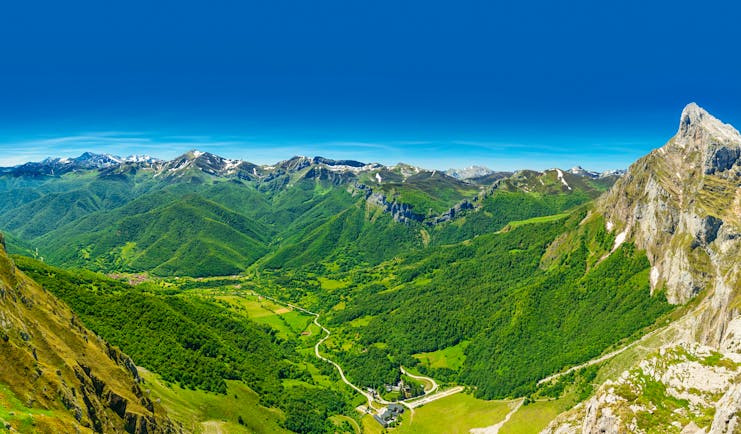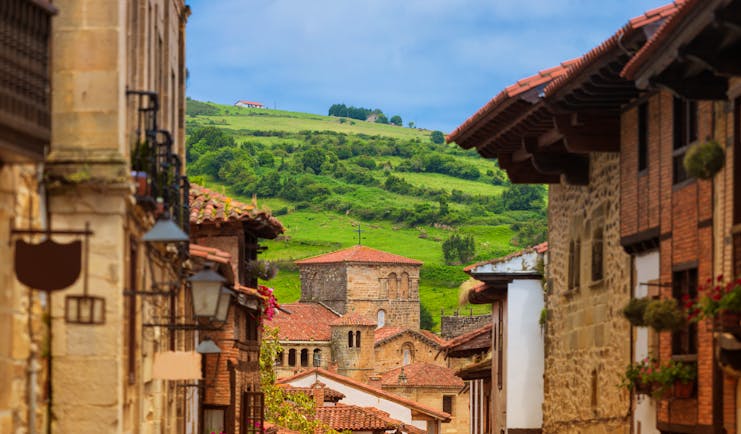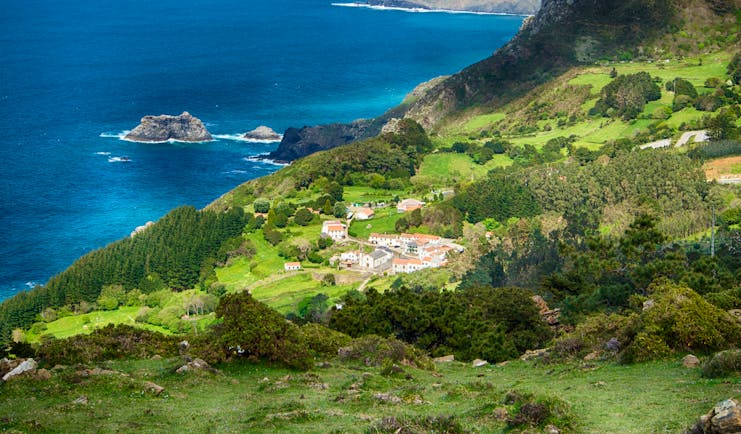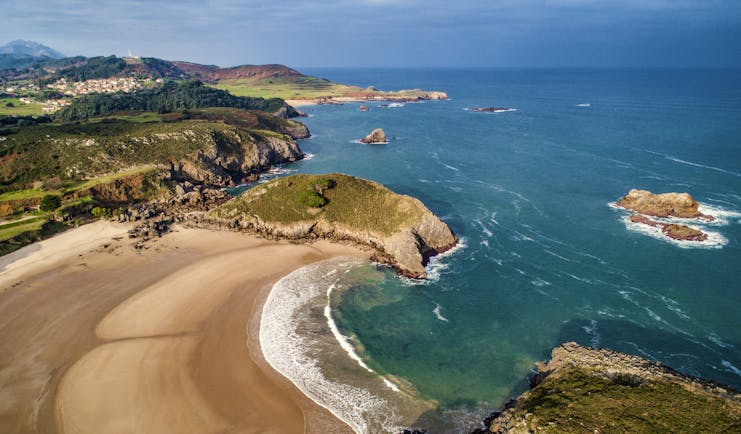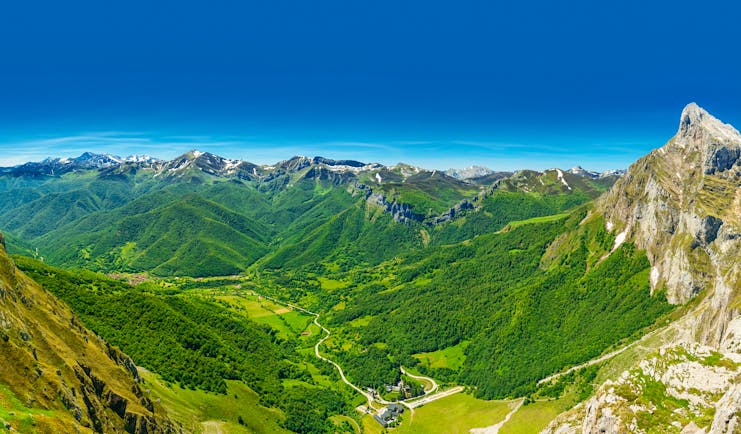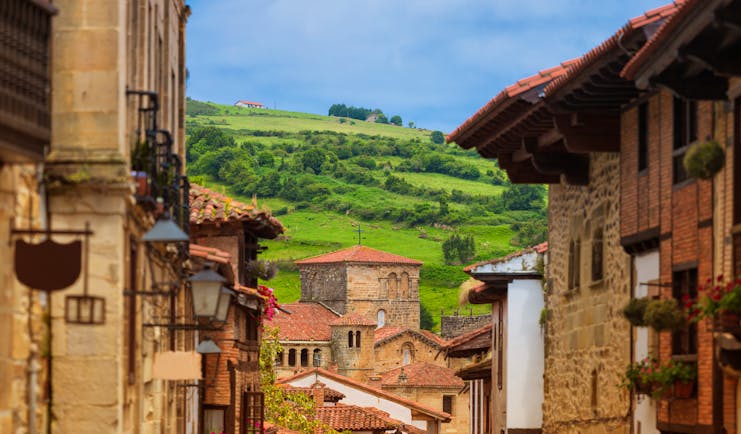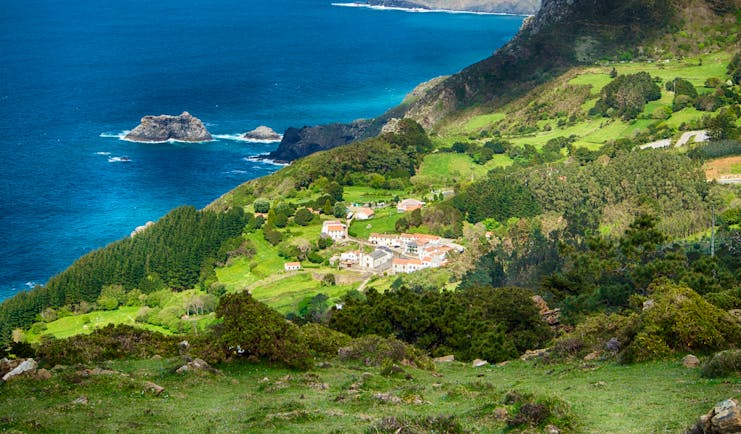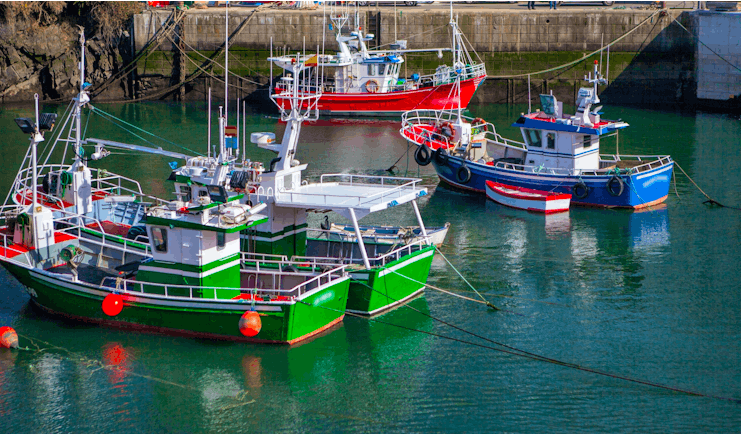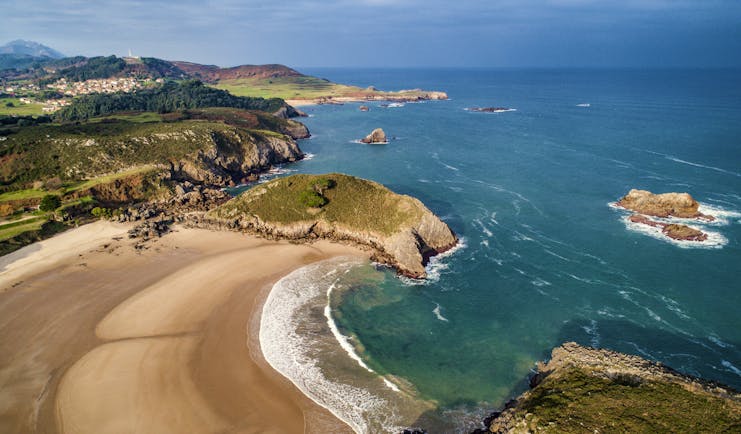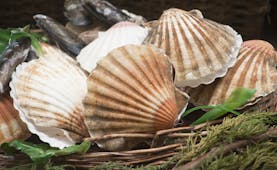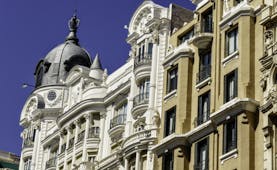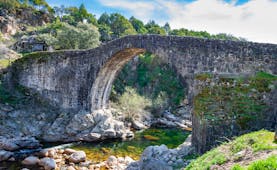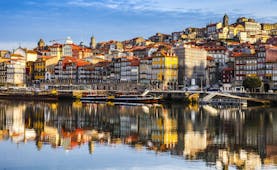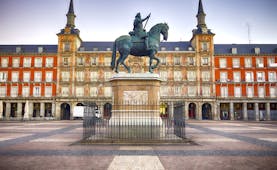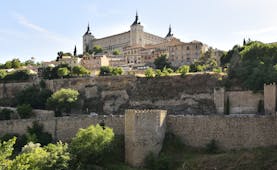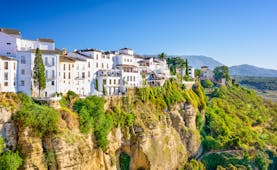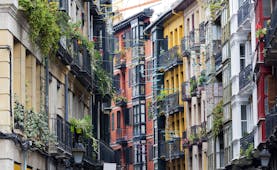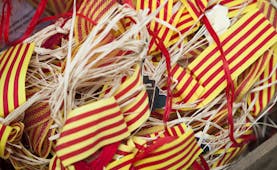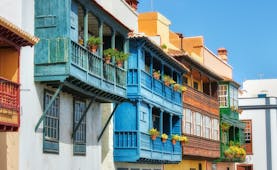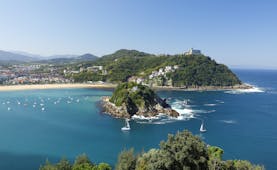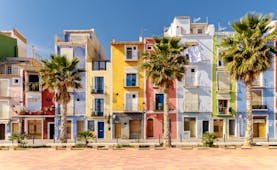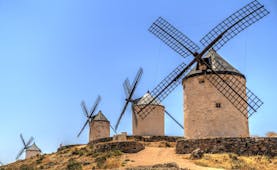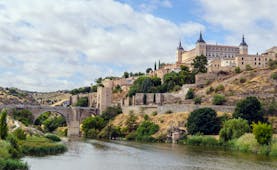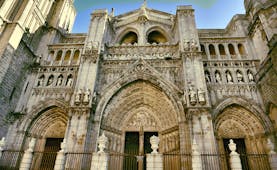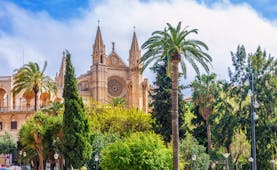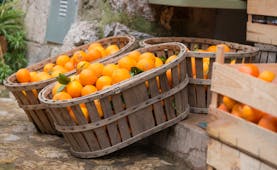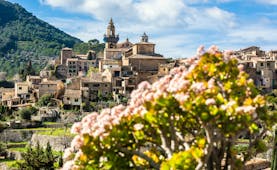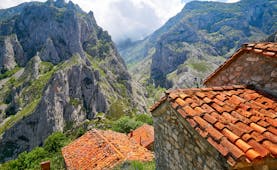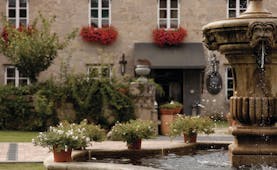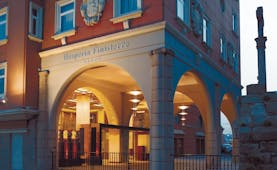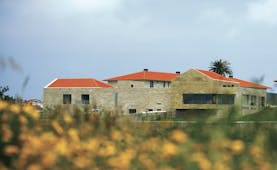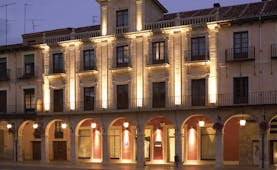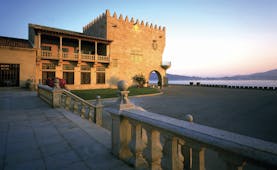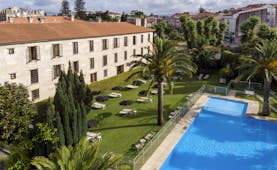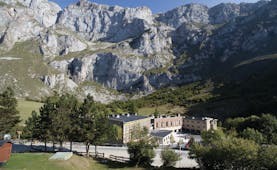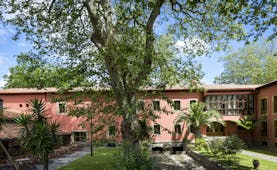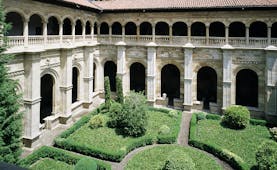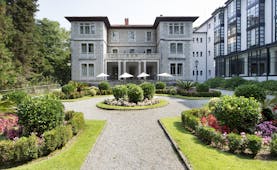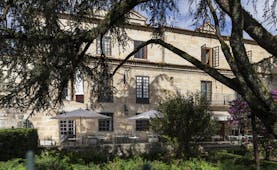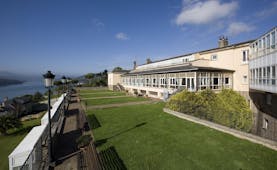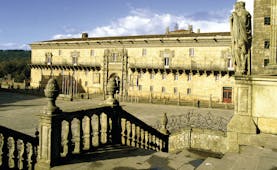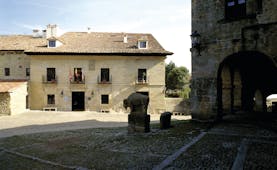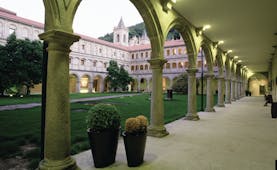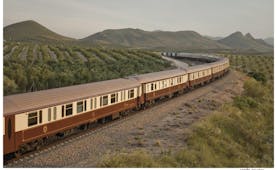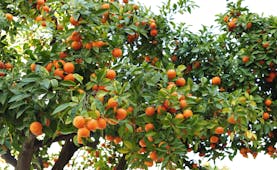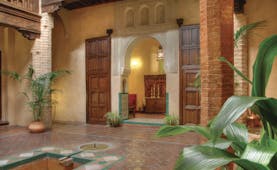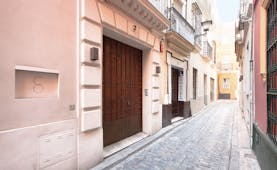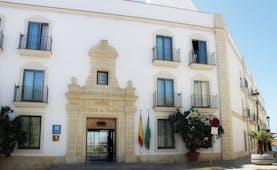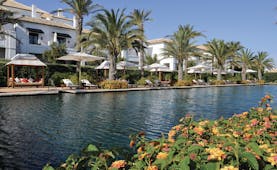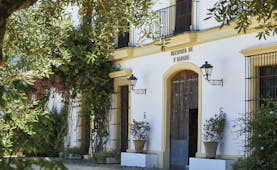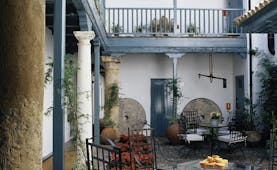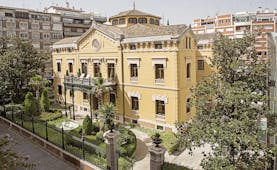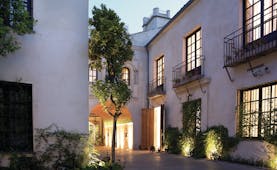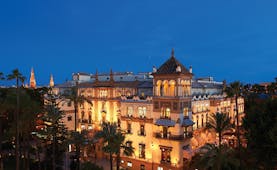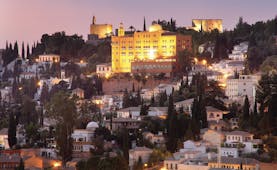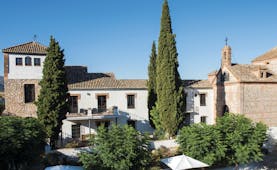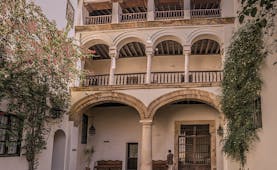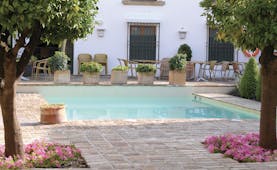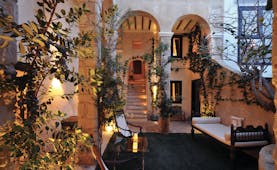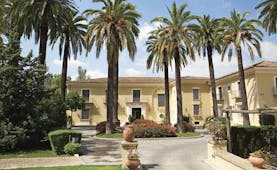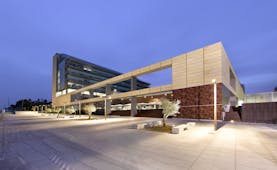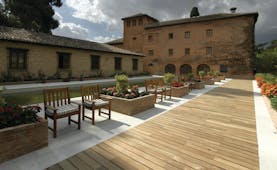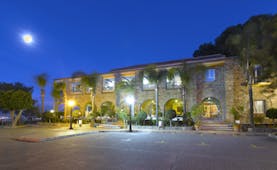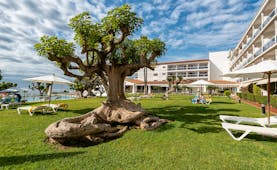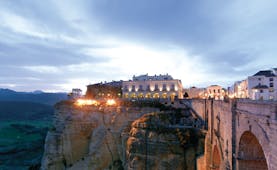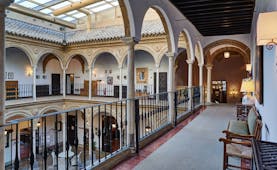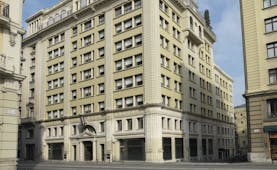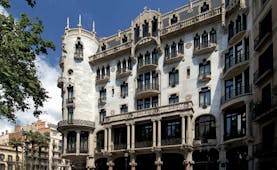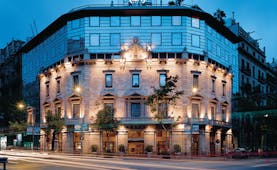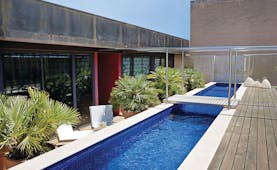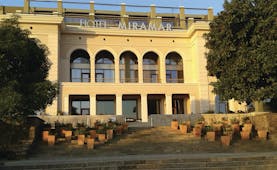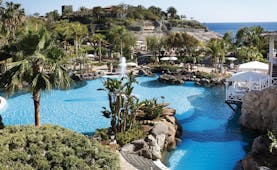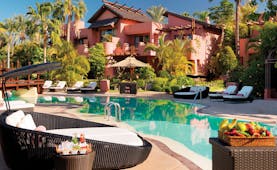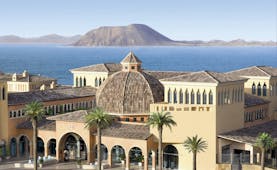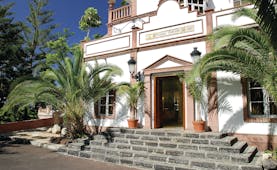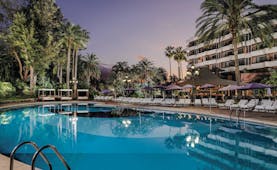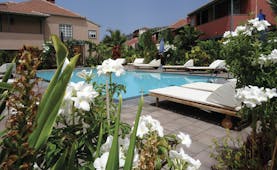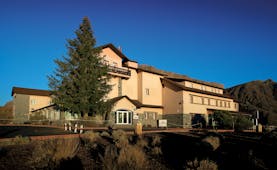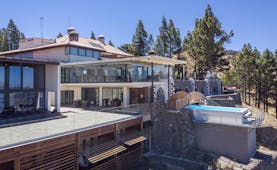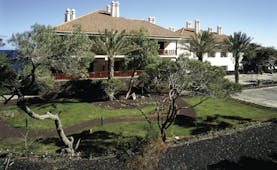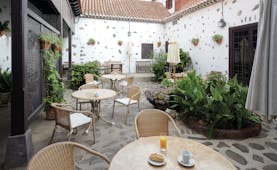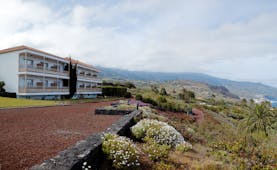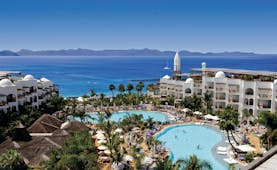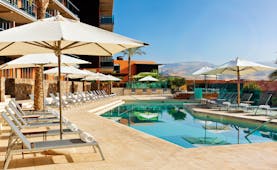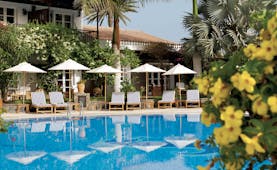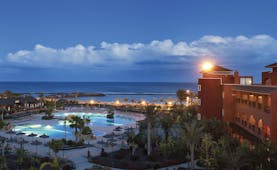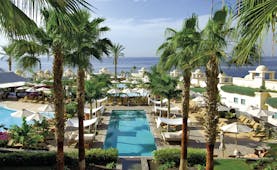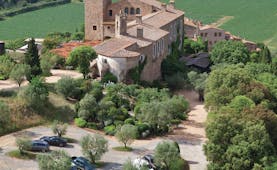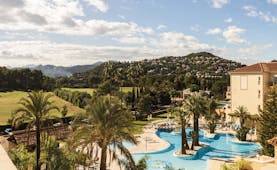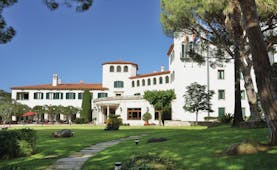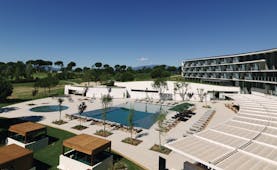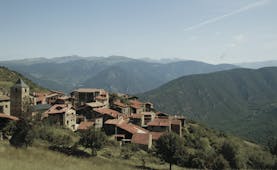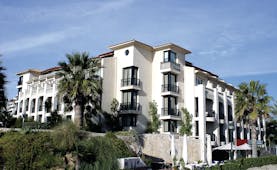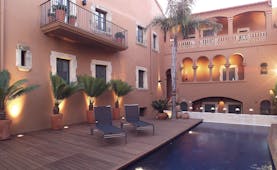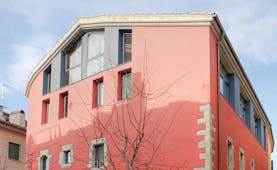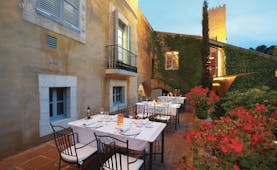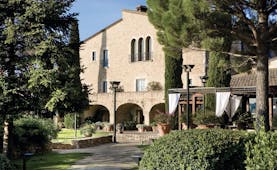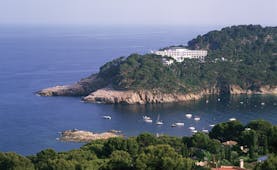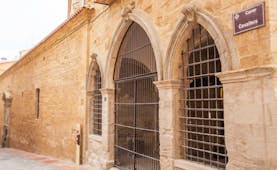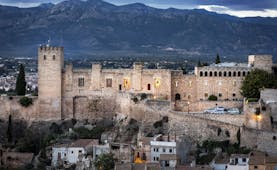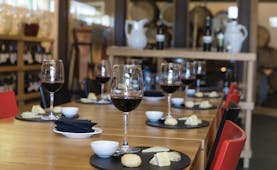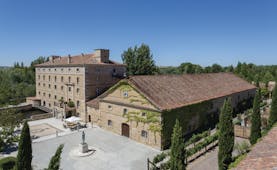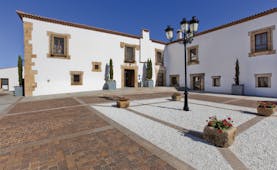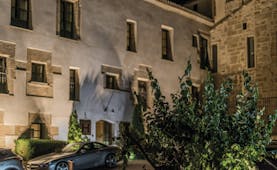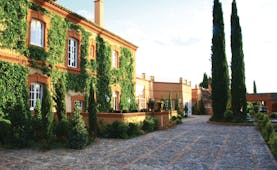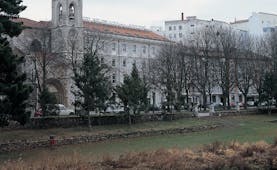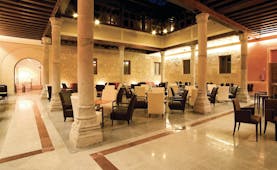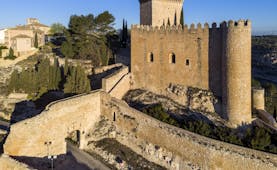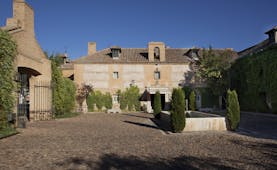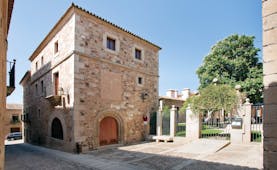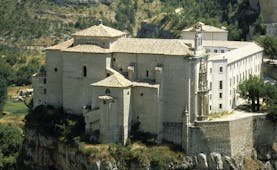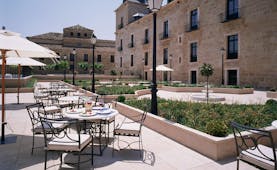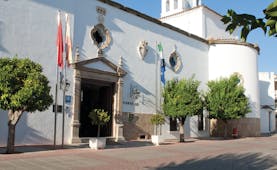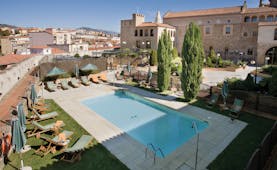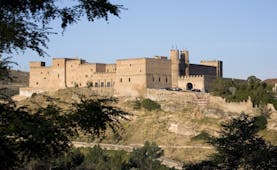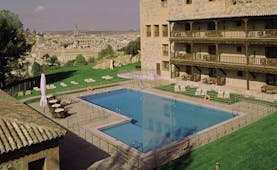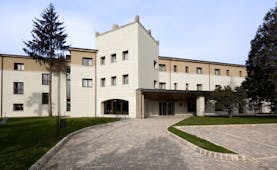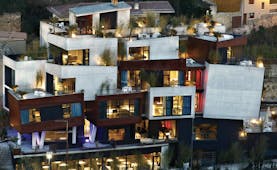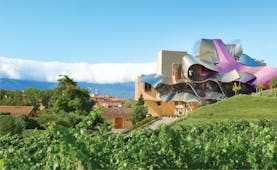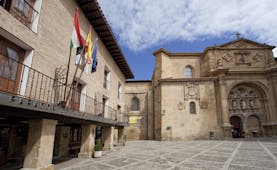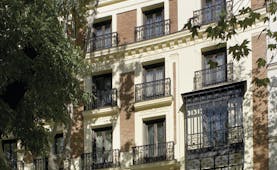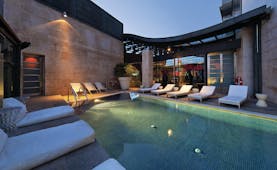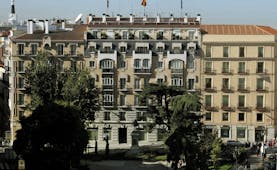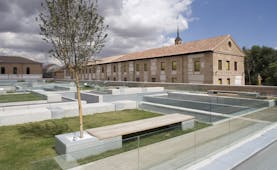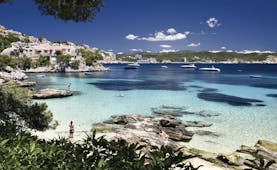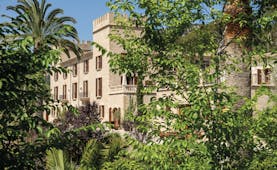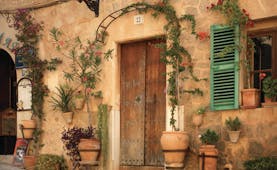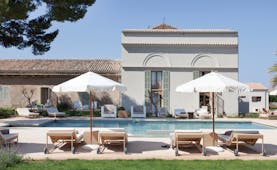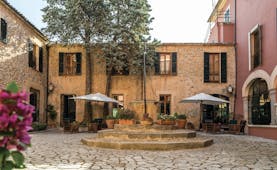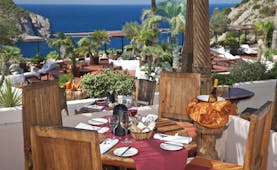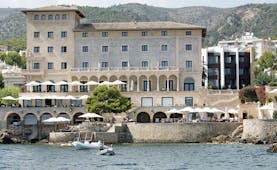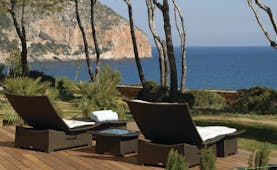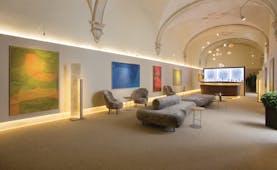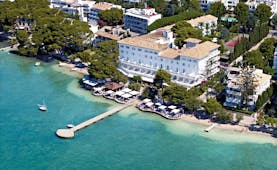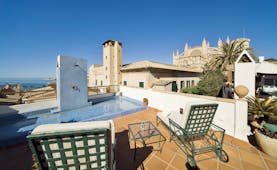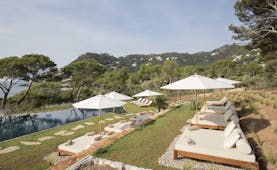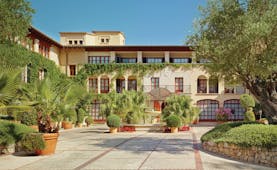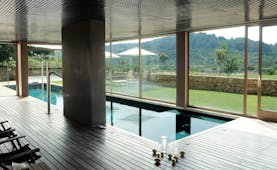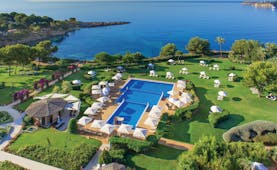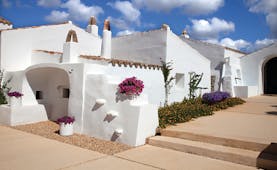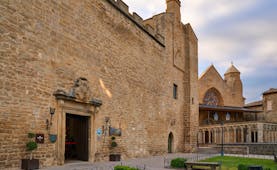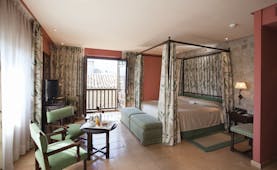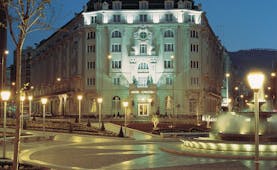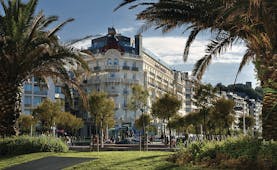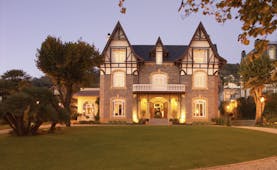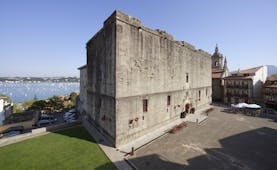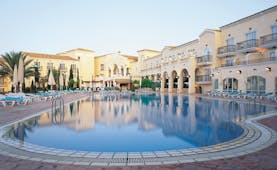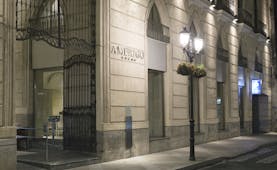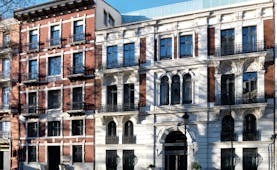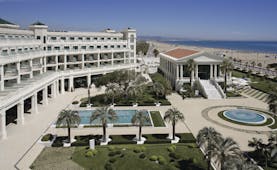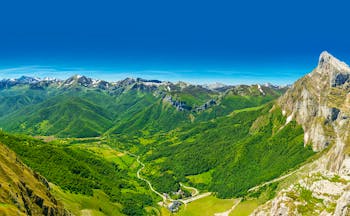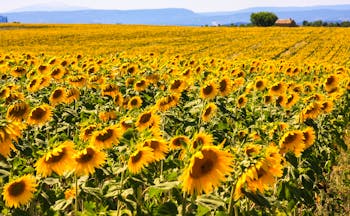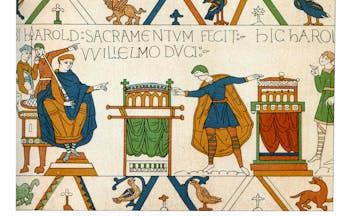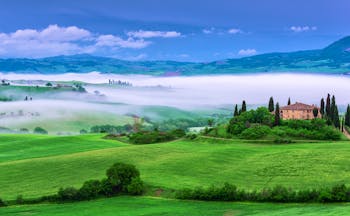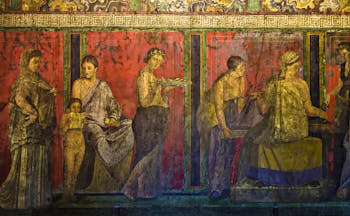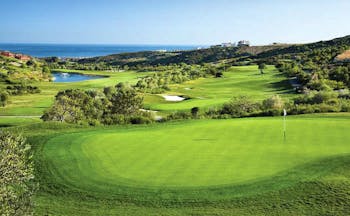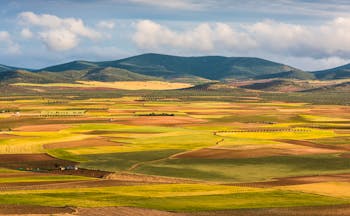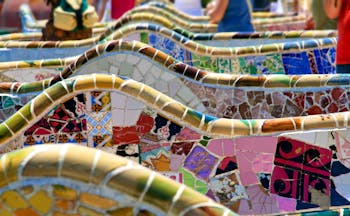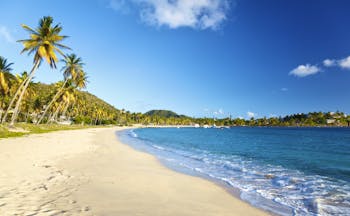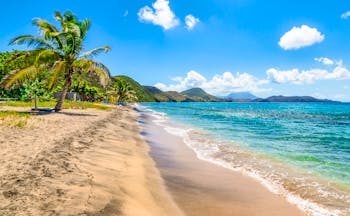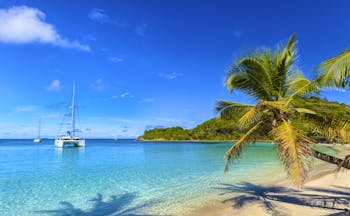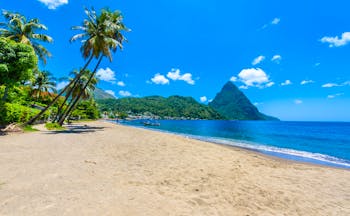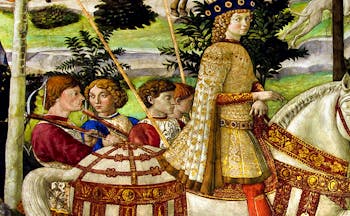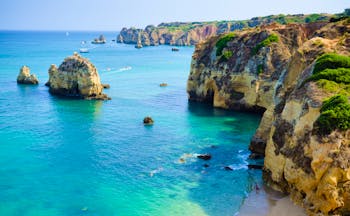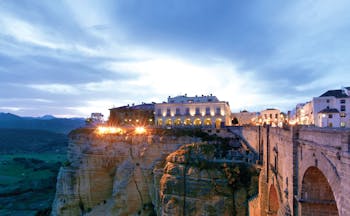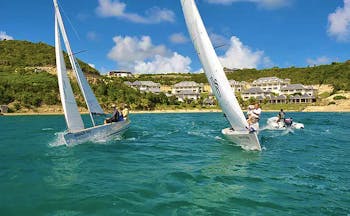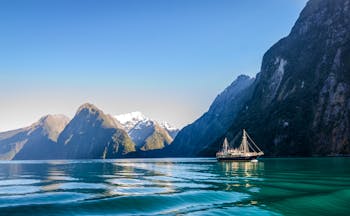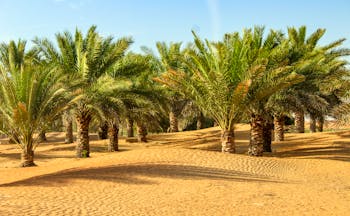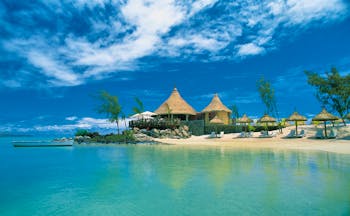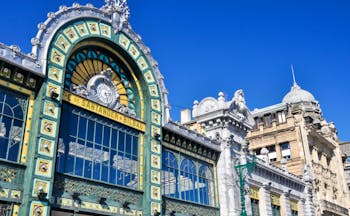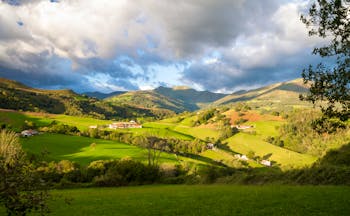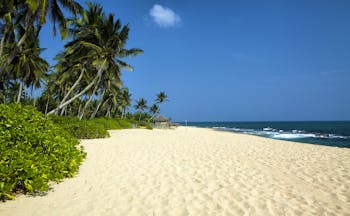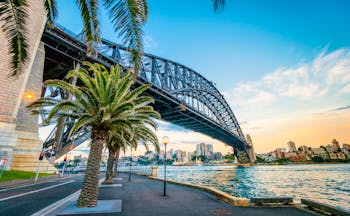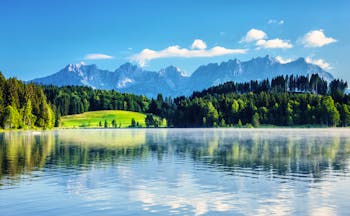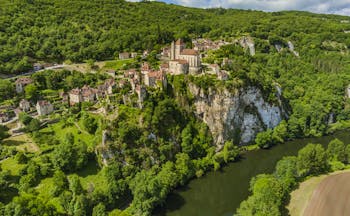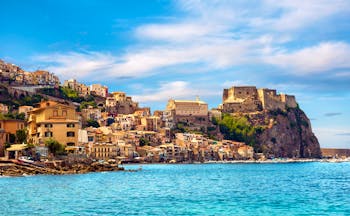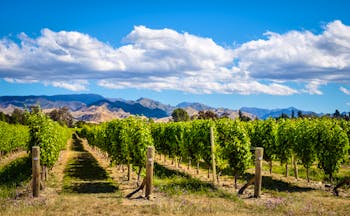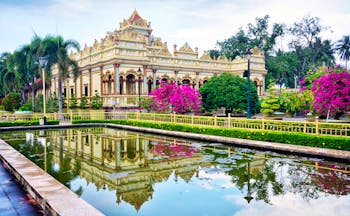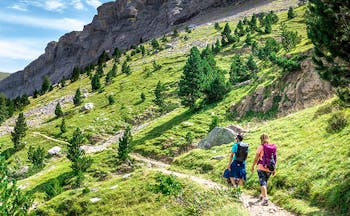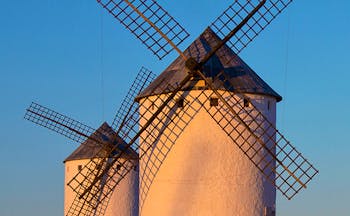Luxury self-drive touring holiday to northern, Green Spain, staying on the coast and in the country and in the cities of Santiago de Compostela and Leon
This 11-night self-drive luxury touring holiday of the coast and country of Green Spain takes you through the northern Spanish regions of Cantabria, Asturias and Galicia, exploring both the dramatic coastline, its quaint fishing ports and long sandy beaches and the verdant, mountainous hinterland. This self-drive luxury touring holiday begins in the picturesque town of Santillana Gil Blas, after your arrival by ferry from Portsmouth or Plymouth at Santander. On the Cantabrian coast, this mediaeval town is distinguished by its sloping streets lined with ochre-stone buildings. It is at the Parador de Santillana Gil Blas, a pretty hotel that combines the historic with the contemporary, that you will spend your first two nights on the Spanish coast. Explore the Altamira Caves, famous for their prehistoric cave paintings, and the serene beaches of the nearby coastal towns, such as Suances. From here, drive on to Luces, near Lastres, in Asturias, and spend two nights at the Hotel Palacio de Luces, stopping off on the way in Comillas to see Antoni Gaudi’s El Capricho. You are perfectly placed to explore the creeping seaside villages that decorate the verdant shore, like a Spanish twist on Italy’s Amalfi Coast. Drive out to Llanes, Lastres, and Luanco to take in the art, architecture, and views. Next, this tour takes you on to the NH Collection Finisterre on the peninsula of A Coruña, Galicia, where you will spend two nights. Your hotel is situated just a short distance from the oldest working Roman lighthouse, commissioned by the Emperor Trajan in the 2nd century. This historic structure sets the tone for your varied and informative stay in A Coruña, visiting the modern museums and aquarium, the various quaint churches, and the Castle of San Antón on its own peninsula. Remain in Galicia for your next two nights, but move south to Santiago de Compostela, capital of Galicia, and the destination of the Saint James pilgrimage route. Your hotel is the A Quinta da Auga Hotel Spa, a charming retreat with an abundance of rustic charm. Use this as the base for your exploration of the Rías Baixas, and the city’s impressive cathedral. This building in itself may prove to be the highlight of your tour. Next, drive inland towards León, stopping off at the rising red cliffs of Las Médulas, an ancient Roman gold mine. The Parador de León, however, awaits you for this overnight stay. Spend the rest of your day exploring the treasures of this walled city, from the stained glass of the cathedral, to the two fairytale works of Gaudi. Move on from here to Camaleño, an idyllic village nestled between the rising hills of the valley, with snow-capped mountains in the background. Take the cable car to the top of the hill behind the Parador de Fuente Dé to witness the breath-taking views. Return, after your last night, to Santander for your return ferry to Portsmouth or Plymouth.
Highlights
Santillana del Mar • Altamira Caves • Luces • Lanes • Lastres • Luanco • Comillas • A Coruna • Aquarium Finisterre • Roman lighthouse • Santiago de Compostela • Rias Baixas • Leon • Camaleno
Day by day
Start your touring holiday by taking the ferry with Brittany Ferries from Portsmouth or Plymouth to Santander, an overnight crossing taking just over 24 hours.
Arrive into Santander in the early evening and drive under half an hour to Santillana del Mar, a pretty mediaeval town just a few miles away from the coast. Stay at the Parador de Santillana Gil Blas. Explore the ochre-stone sloping streets and view the numerous historic buildings, some of which have either wooden galleries or iron balconies. These mediaeval streets, dotted with Renaissance palaces and historic defence towers, centre around the collegiate Church of Santa Juliana. This Romanesque church is of a surprising scale and grandeur for a small town, with an intriguing irregular layout, and a beautiful cloister of intricately carved pillars depicting animals, biblical scenes, Arabian and Norman motifs, and flora. One defensive tower, Merino’s Tower, is now a cultural centre that displays temporary, rotating exhibitions. For a taste of contemporary Cantabrian art, the works of local sculptor Jesús Otero can be seen in the museum of the same name. For those looking to spend some time relaxing in the Spanish sun, the beautiful Santa Justa beach is very nearby in Ubiarco. The small chapel of Santa Justa is built into the undulating rock face, giving the effect of a building that is totally at one with the landscape, and making this beach unique among Spanish beaches. Nearby interesting excursions include Dichoso Point in the town of Suances, a natural harbour backed by a cliff which is lined with shallow beaches perfect for sunbathing and swimming. Torrelavega is the second largest town in Cantabria. Its Viérnoles Monumental site is defined by the impressive 17th and 19th century palaces that surround it. Mid-August sees the Virgen Grande fiestas enliven the town with floral galas and parades. At your hotel, the rooms are light and airy, but with the formidable weight of history captured in the oak floors, dark wood shutters, and atmospheric beamed ceilings. Very typically Spanish, this hotel offers sensational food, luxury accommodation, and spectacular scenery, including the hotel’s own serene cloister. The Parador de Santillana Gil Blas and the surrounding area are the perfect start to this tour of Spain, offering a fascinating insight into the Cantabrian way of life that extends far beyond contemporary architecture into the region’s rich and extensive history.
Just outside the town are the Altamira Caves, a UNESCO World Heritage Site sometimes referred to as the Sistine Chapel of the Palaeolithic Age, with rock paintings of up to 20000 years old. We recommend stopping here before continuing your journey west. Although it is not usually possible to visit the caves themselves, there is an interesting museum where you can find out more about the paintings and the era from which they date and see a faithful replica of the original paintings. Drive westwards along Spain’s north coast, passing through coastal towns and villages as you head towards Hotel Palacio de Luces. The second stop on this luxury touring holiday brings you into Asturias, much like its Cantabrian neighbour, but with an even greater focus on the beauty and merits of climbing coastal villages. Perhaps stop to admire the El Capricho in Comillas, designed in the Modernist style by Antoni Gaudi, or take a break in the historic port of Llanes. 40 minutes west of Luces, your destination, Llanes is a town whose shore is lined with colourful ‘Cubes of Memory’, designed by Agustín Ibarrola. The old town stretches out on both sides of the Carrucedo River with rows of red and gold houses. Perhaps stop off for tapas in the early afternoon or visit the Gothic church and defensive tower. Spend two nights at the relaxing, five-star Palacio de Luces, set amid stunning scenery between the mountains and the sea.
You will have plenty of time on your fourth day to explore the surrounding area, including the nearby fishing village of Lastres and the mountainous landscapes inland which stretch to the Picos de Europa Mountains. Lastres is reminiscent of towns such as Positano and Ravello on the Amalfi Coast in Italy, but with clay-roofed houses and deep green vegetation that do not fail to single it out as Spanish. A lookout point at the top of the town allows you to capture the entire essence of the town in one sweeping view across the sea and down the zigzagging streets. A 45-minute drive west will take you to another famous coastal village: Luanco, with its eccentrically designed colourful beach-side houses, each of which seems to have its own unique take on the local architectural style. Further inland is the capital of Asturias, Oviedo, a town inextricably linked with the region’s monarchy and which bears the stamp of its mediaeval history on every street. This is an excellent excursion for those looking to delve into pre-Romanesque Spanish art and explore another UNESCO World Heritage Site. Your hotel for these two nights is another property of gastronomic excellence, which serves highly refined local food. It occupies a privileged position inland from Lastres, in Luces, with rooms decorated with exceptional contemporary warmth, and with a glass-walled dining room that looks out across the fields and mountains in the distance.
Continue along the Asturian coastline from Luces into Galicia to the maritime city of A Coruña. Stay for two nights at Hesperia Finisterre, a five-star hotel located by the city’s harbour where you can easily walk to the Tower of Hercules, the oldest Roman lighthouse still in use today, dating back to the 2nd century and commissioned by the Emperor Trajan.
The old town of A Coruña stretches out onto a pretty peninsula. Its Romanesque streets and squares lead you past its collection of mediaeval churches. The Church of Santiago is perhaps the most beautiful, as it is the oldest in the city and is comprised of several pointed arches. The Santa María del Campo holds a very interesting Museum of Religious Art and has been declared a Historic-Artistic Monument; while the Convent of Santa Bárbara and its eponymous square are listed as a Historic-Artistic Site. Such traditional, austere buildings seem to submerge the town in its history and radiate a peaceful atmosphere. To see some of the town’s Baroque architecture, we would recommend visiting the 18th century Los Capuchinos church, and the narrow tower of the Convent of Santo Domingo. At the very centre of the town is the remarkable San Carlos Garden, encased in the walls of the fortress of San Carlos. This site also houses the tomb of Sir John Moore, an English soldier, and the Archive of the Kingdom of Galicia, making it an exceptional site with a rich and complicated history. At the end of the harbour, sits the Castle of San Antón, which dates from the 16th century and houses the Provincial Archaeological Museum, specialising in Galician prehistory. A sprawling, low-lying structure, it is surrounded on three sides by short rocky cliffs and the sea. The ramparts of the castle offer fantastic views back into the harbour, or off into the horizon. Three ultra-modern museums are dotted around the town: the Aquarium Finisterre, one of the largest in Spain; the Domus museum of human history; and the Science Museum with its inspirational planetarium. During your stay in northern Galicia you can also discover the wild ‘Costa da Morte’ and explore the Rías Altas, which are interspersed with quaint fishing villages. A wonderful stop-off point from which to explore the wonders of the Galician coast, its gastronomy, and its history, the Hesperia Finisterre is a contemporary hotel with refined chic designs and a private roof terrace.
Drive around one hour southwards to the Galician capital, Santiago de Compostela, where you stay for two nights at A Quinta da Auga Hotel Spa, a relaxing hotel just outside the city centre. Santiago de Compostela’s Romanesque cathedral was begun in the 11th century, but it wasn’t until the 13th century that it was finished. As a result, its design is a menagerie of different styles, which makes it a thoroughly fulfilling afternoon activity. It is reportedly the resting place of St James the Apostle, whose tomb can be viewed on-site. On the exterior, the wealth of decorative and iconographic details were added in the early 18th century, and are a breath-taking example of perfected Baroque art. The merit of this architectural tour-de-force continues inside with the Plateresque cloister, believed to be one of the most important in Spain. The annex rooms off this cloister include the library, Chapter Room, and the Chapel of Relics, which houses a series of wonderfully ornate golden pieces. The Ceremonial Room has a grandiose arched ceiling and corbels that depict a royal banquet. As the destination of the Saint James Pilgrimage Route, it is not hard to understand the attraction this building affords the city. Taking place in July, the fiestas in the name of the Apostle Santiago have been given the badge of International Tourist Interest, and fill the city’s streets with music, games, entertainment and, above all, colour.
Perhaps venture westwards to the Atlantic coast, where you can enjoy more of the stunning scenery from the inlets of the Rías Baixas, taste the sensational shellfish and white wine, and visit picturesque towns and villages. The green surrounding countryside is perfect for those looking to explore the area on foot, by hiking or fishing; while a range of sports such a golf and cycling are also available. The landscape is punctuated by the undulating roofs of Pazos, or ancient homes, Hórreos, or stone granaries, and forts, monasteries, and acropolises. To finish off your nights in Galicia, try some of the regional specialities. So close to the coast, seafood plays a large part in the local cuisine, particularly small crabs, barnacles, and a delicious angler fish stew. Besides this, Galician pork and beef are very well received, and best accompanied by local wines such as Monterrei, Ribeiro, Rías Baixas, and Valdeorras.
Drive eastwards through rolling green countryside and wooded hills towards León, an attractive walled city with an impressive cathedral, a Royal Pantheon, and a picturesque old town. On the way, perhaps stop off at Las Médulas, an ancient Roman gold mine with tunnels that can be explored. These craggy red cliffs rupture the serenity of the green countryside in quite a surreal way and appear almost to be a civilisation by themselves. Stay at the Parador de León for one night, situated within the Convent of San Marcos, which was once a hospital for pilgrims on their way to Santiago de Compostela. The town’s 13th century cathedral is known as The House of Light because of its beautiful stained glass, which is radiantly colourful and casts a golden glow across the cavernous building’s interior. Also standing out on León’s streets are Gaudi’s Casa de los Botines and his Palacio Episcopal de Astorga. Somewhat reserved in comparison to his other works, the Casa de los Botines has a soft, rounded appearance, reminiscent of fairytale inventions of mediaeval castles, both typical and atypical of his style, and tall, thin turrets. The MUSAC houses a vast collection of prestigious contemporary art. It aims to take a revolutionary outlook on modern work, which means that many of its exhibitions are very experimental and challenging. Modern aspects of the city contrast delightfully with the older features, such as the fairytale Palacio Episcopal de Astorga, with its thin arched windows and narrow turrets, framing León as a vital insight into the progression of this region of Spain.
Head northwards towards the Picos de Europa Mountains which divide Green Spain from the region of Castilla y León. Stay for one night at the Parador de Fuente Dé, a simple hotel nestled in a verdant valley, with the contrasting scenery of snowing mountain peaks. Its main building absorbs the beauty of the landscape through its many glass walls and windows, reflecting the green of the hills and the grey of the irregular rock faces. Visitors here can ascend the steep cableway which takes you to the Áliva viewpoint, from which you can take in breath-taking views of rocky peaks and forested valleys and appreciate the idyllic seclusion of this series of quaint, traditional villages and hamlets. Before leaving Cantabria, be sure to spend a few hours at the Monastery of Santo Toribio de Liébana near the villages of Mieses and Turieno. Dating back to the 7th century, this is the former home of the monk Beato, known for his commentary on the apocalypse. This charming gold-stone building sits against a backdrop of densely packed trees, and with views down into the valley. The well-maintained building exudes a feeling of calm, which draws on the sublimity of the landscape. This seems a very fitting end to this diverse, luxury tour of Northern Spain.
Drive northwards to Santander to board your return ferry for the homeward journey, and overnight on the boat, arriving in the UK the next day.
Excellent. So much easier coming to you than trying to book accommodation ourselves. Will certainly come to you again, especially for a self-drive holiday.Mr D, Sep 2023
Holiday price guide Prices from £2,145 per person based on two people sharing a double or twin room.
Holiday Code SNSD02
Call us on 01392 441245
Luxury self-drive touring holiday to northern, Green Spain, staying on the coast and in the country and in the cities of Santiago de Compostela and Leon
Start your touring holiday by taking the ferry with Brittany Ferries from Portsmouth or Plymouth to Santander, an overnight crossing taking just over 24 hours.
Arrive into Santander in the early evening and drive under half an hour to Santillana del Mar, a pretty mediaeval town just a few miles away from the coast. Stay at the Parador de Santillana Gil Blas. Explore the ochre-stone sloping streets and view the numerous historic buildings, some of which have either wooden galleries or iron balconies. These mediaeval streets, dotted with Renaissance palaces and historic defence towers, centre around the collegiate Church of Santa Juliana. This Romanesque church is of a surprising scale and grandeur for a small town, with an intriguing irregular layout, and a beautiful cloister of intricately carved pillars depicting animals, biblical scenes, Arabian and Norman motifs, and flora. One defensive tower, Merino’s Tower, is now a cultural centre that displays temporary, rotating exhibitions. For a taste of contemporary Cantabrian art, the works of local sculptor Jesús Otero can be seen in the museum of the same name. For those looking to spend some time relaxing in the Spanish sun, the beautiful Santa Justa beach is very nearby in Ubiarco. The small chapel of Santa Justa is built into the undulating rock face, giving the effect of a building that is totally at one with the landscape, and making this beach unique among Spanish beaches. Nearby interesting excursions include Dichoso Point in the town of Suances, a natural harbour backed by a cliff which is lined with shallow beaches perfect for sunbathing and swimming. Torrelavega is the second largest town in Cantabria. Its Viérnoles Monumental site is defined by the impressive 17th and 19th century palaces that surround it. Mid-August sees the Virgen Grande fiestas enliven the town with floral galas and parades. At your hotel, the rooms are light and airy, but with the formidable weight of history captured in the oak floors, dark wood shutters, and atmospheric beamed ceilings. Very typically Spanish, this hotel offers sensational food, luxury accommodation, and spectacular scenery, including the hotel’s own serene cloister. The Parador de Santillana Gil Blas and the surrounding area are the perfect start to this tour of Spain, offering a fascinating insight into the Cantabrian way of life that extends far beyond contemporary architecture into the region’s rich and extensive history.
Just outside the town are the Altamira Caves, a UNESCO World Heritage Site sometimes referred to as the Sistine Chapel of the Palaeolithic Age, with rock paintings of up to 20000 years old. We recommend stopping here before continuing your journey west. Although it is not usually possible to visit the caves themselves, there is an interesting museum where you can find out more about the paintings and the era from which they date and see a faithful replica of the original paintings. Drive westwards along Spain’s north coast, passing through coastal towns and villages as you head towards Hotel Palacio de Luces. The second stop on this luxury touring holiday brings you into Asturias, much like its Cantabrian neighbour, but with an even greater focus on the beauty and merits of climbing coastal villages. Perhaps stop to admire the El Capricho in Comillas, designed in the Modernist style by Antoni Gaudi, or take a break in the historic port of Llanes. 40 minutes west of Luces, your destination, Llanes is a town whose shore is lined with colourful ‘Cubes of Memory’, designed by Agustín Ibarrola. The old town stretches out on both sides of the Carrucedo River with rows of red and gold houses. Perhaps stop off for tapas in the early afternoon or visit the Gothic church and defensive tower. Spend two nights at the relaxing, five-star Palacio de Luces, set amid stunning scenery between the mountains and the sea.
You will have plenty of time on your fourth day to explore the surrounding area, including the nearby fishing village of Lastres and the mountainous landscapes inland which stretch to the Picos de Europa Mountains. Lastres is reminiscent of towns such as Positano and Ravello on the Amalfi Coast in Italy, but with clay-roofed houses and deep green vegetation that do not fail to single it out as Spanish. A lookout point at the top of the town allows you to capture the entire essence of the town in one sweeping view across the sea and down the zigzagging streets. A 45-minute drive west will take you to another famous coastal village: Luanco, with its eccentrically designed colourful beach-side houses, each of which seems to have its own unique take on the local architectural style. Further inland is the capital of Asturias, Oviedo, a town inextricably linked with the region’s monarchy and which bears the stamp of its mediaeval history on every street. This is an excellent excursion for those looking to delve into pre-Romanesque Spanish art and explore another UNESCO World Heritage Site. Your hotel for these two nights is another property of gastronomic excellence, which serves highly refined local food. It occupies a privileged position inland from Lastres, in Luces, with rooms decorated with exceptional contemporary warmth, and with a glass-walled dining room that looks out across the fields and mountains in the distance.
Continue along the Asturian coastline from Luces into Galicia to the maritime city of A Coruña. Stay for two nights at Hesperia Finisterre, a five-star hotel located by the city’s harbour where you can easily walk to the Tower of Hercules, the oldest Roman lighthouse still in use today, dating back to the 2nd century and commissioned by the Emperor Trajan.
The old town of A Coruña stretches out onto a pretty peninsula. Its Romanesque streets and squares lead you past its collection of mediaeval churches. The Church of Santiago is perhaps the most beautiful, as it is the oldest in the city and is comprised of several pointed arches. The Santa María del Campo holds a very interesting Museum of Religious Art and has been declared a Historic-Artistic Monument; while the Convent of Santa Bárbara and its eponymous square are listed as a Historic-Artistic Site. Such traditional, austere buildings seem to submerge the town in its history and radiate a peaceful atmosphere. To see some of the town’s Baroque architecture, we would recommend visiting the 18th century Los Capuchinos church, and the narrow tower of the Convent of Santo Domingo. At the very centre of the town is the remarkable San Carlos Garden, encased in the walls of the fortress of San Carlos. This site also houses the tomb of Sir John Moore, an English soldier, and the Archive of the Kingdom of Galicia, making it an exceptional site with a rich and complicated history. At the end of the harbour, sits the Castle of San Antón, which dates from the 16th century and houses the Provincial Archaeological Museum, specialising in Galician prehistory. A sprawling, low-lying structure, it is surrounded on three sides by short rocky cliffs and the sea. The ramparts of the castle offer fantastic views back into the harbour, or off into the horizon. Three ultra-modern museums are dotted around the town: the Aquarium Finisterre, one of the largest in Spain; the Domus museum of human history; and the Science Museum with its inspirational planetarium. During your stay in northern Galicia you can also discover the wild ‘Costa da Morte’ and explore the Rías Altas, which are interspersed with quaint fishing villages. A wonderful stop-off point from which to explore the wonders of the Galician coast, its gastronomy, and its history, the Hesperia Finisterre is a contemporary hotel with refined chic designs and a private roof terrace.
Drive around one hour southwards to the Galician capital, Santiago de Compostela, where you stay for two nights at A Quinta da Auga Hotel Spa, a relaxing hotel just outside the city centre. Santiago de Compostela’s Romanesque cathedral was begun in the 11th century, but it wasn’t until the 13th century that it was finished. As a result, its design is a menagerie of different styles, which makes it a thoroughly fulfilling afternoon activity. It is reportedly the resting place of St James the Apostle, whose tomb can be viewed on-site. On the exterior, the wealth of decorative and iconographic details were added in the early 18th century, and are a breath-taking example of perfected Baroque art. The merit of this architectural tour-de-force continues inside with the Plateresque cloister, believed to be one of the most important in Spain. The annex rooms off this cloister include the library, Chapter Room, and the Chapel of Relics, which houses a series of wonderfully ornate golden pieces. The Ceremonial Room has a grandiose arched ceiling and corbels that depict a royal banquet. As the destination of the Saint James Pilgrimage Route, it is not hard to understand the attraction this building affords the city. Taking place in July, the fiestas in the name of the Apostle Santiago have been given the badge of International Tourist Interest, and fill the city’s streets with music, games, entertainment and, above all, colour.
Perhaps venture westwards to the Atlantic coast, where you can enjoy more of the stunning scenery from the inlets of the Rías Baixas, taste the sensational shellfish and white wine, and visit picturesque towns and villages. The green surrounding countryside is perfect for those looking to explore the area on foot, by hiking or fishing; while a range of sports such a golf and cycling are also available. The landscape is punctuated by the undulating roofs of Pazos, or ancient homes, Hórreos, or stone granaries, and forts, monasteries, and acropolises. To finish off your nights in Galicia, try some of the regional specialities. So close to the coast, seafood plays a large part in the local cuisine, particularly small crabs, barnacles, and a delicious angler fish stew. Besides this, Galician pork and beef are very well received, and best accompanied by local wines such as Monterrei, Ribeiro, Rías Baixas, and Valdeorras.
Drive eastwards through rolling green countryside and wooded hills towards León, an attractive walled city with an impressive cathedral, a Royal Pantheon, and a picturesque old town. On the way, perhaps stop off at Las Médulas, an ancient Roman gold mine with tunnels that can be explored. These craggy red cliffs rupture the serenity of the green countryside in quite a surreal way and appear almost to be a civilisation by themselves. Stay at the Parador de León for one night, situated within the Convent of San Marcos, which was once a hospital for pilgrims on their way to Santiago de Compostela. The town’s 13th century cathedral is known as The House of Light because of its beautiful stained glass, which is radiantly colourful and casts a golden glow across the cavernous building’s interior. Also standing out on León’s streets are Gaudi’s Casa de los Botines and his Palacio Episcopal de Astorga. Somewhat reserved in comparison to his other works, the Casa de los Botines has a soft, rounded appearance, reminiscent of fairytale inventions of mediaeval castles, both typical and atypical of his style, and tall, thin turrets. The MUSAC houses a vast collection of prestigious contemporary art. It aims to take a revolutionary outlook on modern work, which means that many of its exhibitions are very experimental and challenging. Modern aspects of the city contrast delightfully with the older features, such as the fairytale Palacio Episcopal de Astorga, with its thin arched windows and narrow turrets, framing León as a vital insight into the progression of this region of Spain.
Head northwards towards the Picos de Europa Mountains which divide Green Spain from the region of Castilla y León. Stay for one night at the Parador de Fuente Dé, a simple hotel nestled in a verdant valley, with the contrasting scenery of snowing mountain peaks. Its main building absorbs the beauty of the landscape through its many glass walls and windows, reflecting the green of the hills and the grey of the irregular rock faces. Visitors here can ascend the steep cableway which takes you to the Áliva viewpoint, from which you can take in breath-taking views of rocky peaks and forested valleys and appreciate the idyllic seclusion of this series of quaint, traditional villages and hamlets. Before leaving Cantabria, be sure to spend a few hours at the Monastery of Santo Toribio de Liébana near the villages of Mieses and Turieno. Dating back to the 7th century, this is the former home of the monk Beato, known for his commentary on the apocalypse. This charming gold-stone building sits against a backdrop of densely packed trees, and with views down into the valley. The well-maintained building exudes a feeling of calm, which draws on the sublimity of the landscape. This seems a very fitting end to this diverse, luxury tour of Northern Spain.
Drive northwards to Santander to board your return ferry for the homeward journey, and overnight on the boat, arriving in the UK the next day.
Excellent. So much easier coming to you than trying to book accommodation ourselves. Will certainly come to you again, especially for a self-drive holiday.Mr D, Sep 2023
Holiday price guide Prices from £2,145 per person based on two people sharing a double or twin room.
Holiday Code SNSD02
Our prices include
● Return overnight crossing for car and passengers with Brittany Ferries from Portsmouth or Plymouth to Santander, including an outside cabin for 2 people, both ways
● 2 nights’ bed and breakfast in a standard double room at the Parador de Santillana Gil Blas in Santillana del Mar
● 2 nights’ bed and breakfast in a standard double room at the Hotel Palacio de Luces in Luces
● 2 nights’ bed and breakfast in a standard double room at the Hesperia Finisterre in A Coruña
● 2 nights’ bed and breakfast in a standard double room at the A Quinta da Auga Hotel Spa Relais & Châteaux in Santiago de Compostela
● 1 night’s bed and breakfast in a standard double room at the NH Collection Leon Plaza Mayor
● 1 night’s bed and breakfast in a standard double room at the Parador de Fuente Dé in Camaleño
● Concierge service and Expressions Holidays regional helpful hints
Our prices do not include
● Early check-in or late check-out at any hotels (although we can arrange this on request at additional cost)
● Any other services not mentioned above, such as transfers and meals except breakfast at hotels
● Personal holiday insurance. This is essential and cover should be in place from when you book the holiday.
● Local tourist tax, usually between Euros 1 and 3 per person per night, and payable locally to the hotel
Additional information
Driving times for this touring holiday
Santander to Santillana del Mar 35 minutes
Santillana del Mar to Luces 1 hour 15 minutes
Lastres to A Coruña 3 hours 5 minutes
A Coruña to Santiago de Compostela 55 minutes
Santiago de Compostela to León 3 hours 35 minutes
León to Camaleño 3 hours
Camaleño to Santander 2 hours
Call us on 01392 441245
Luxury self-drive touring holiday to northern, Green Spain, staying on the coast and in the country and in the cities of Santiago de Compostela and Leon
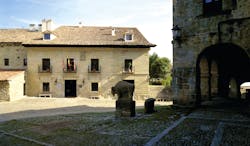
Parador de Santillana Gil Blas is a 4-star, cosy and quaint hideaway in the old town of Santillana del Mar. Elegant and comfortable accommodation and delicious local cuisine afford guests a truly relaxing and indulgent experience.
Standard double room
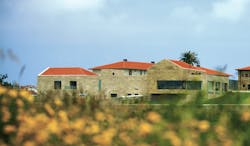
Hotel Palacio de Luces is a five-star Relais & Chateaux hotel between the Sierra de Sueve Mountains and the Cantabrian Sea. Offering comfort amid stunning scenery, it is a perfect retreat after a day of sightseeing.
Standard double room
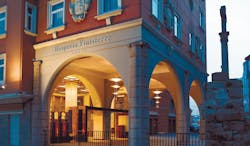
Hesperia Finisterre is a luxury 5-star hotel overlooking the harbour of La Coruña. Delicious cuisine and excellent spa facilities a short walk from the beach afford guests a truly relaxing and indulgent experience.
Standard double room

A Quinta da Auga Hotel Spa is a rural hotel surrounded by immaculate gardens. On the bank of the River Sar, this hotel provides a tranquil and indulgent retreat in comfortable and luxurious surroundings.
Standard double room
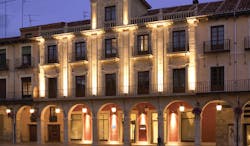
NH Collection León Plaza Mayor is a 4-star boutique hotel in an excellent central location. Juxtaposing historic architectural features with modern facilities, it is a comfortable, elegant spot to recuperate after enjoying the sights of León.
Standard double room

Parador de Fuente Dé is an alpine escape in the Picos de Europa National Park. This comfortable and elegant hotel enjoys magnificent mountain views and is a relaxing retreat after a day of exploring the surrounding countryside.
Standard double room
Excellent. So much easier coming to you than trying to book accommodation ourselves. Will certainly come to you again, especially for a self-drive holiday.Mr D, Sep 2023
Holiday price guide Prices from £2,145 per person based on two people sharing a double or twin room.
Holiday Code SNSD02
Call us on 01392 441245
Luxury self-drive touring holiday to northern, Green Spain, staying on the coast and in the country and in the cities of Santiago de Compostela and Leon
About Green Spain
Green Spain features some of the best four and five star hotels in the regions of Galicia, Asturias and Cantabria in northern Spain, including coastal properties, city hotels and rural retreats. From the pretty rivers on the west coast of Galicia to the spectacular mountains of Asturias and the prehistoric caves of Cantabria, Green Spain is a picturesque area in the north of Spain. With quiet sandy beaches, green landscapes, charming villages and Romanesque architecture lining the famed pilgrimage route which leads to Santiago de Compostela, there is plenty to discover. Although many of those who go on holiday to northern Spain simply pass through en route to Santiago de Compostela, the entire region has much to offer. Stunning beaches are almost untouched, whilst the mild climate has produced rich vegetation which covers unspoilt countryside. Both along the coast and further inland there are attractive cities, towns and villages with a wealth of historical, architectural and cultural sights to discover. Galicia and Asturias have strong cultural identities, both fiercely defending their Celtic traditions which include playing bagpipes, and even speaking their own languages. In the far west is the remote region of Galicia, known as ‘The land of a thousand rivers’ thanks to the numerous wide inlets that run into the sea. The Atlantic coastline is rugged, with rocky headlands, idyllic beaches and isolated fishing villages, whilst the interior is hilly and overwhelmingly green. To the east is the Principality of Asturias, an enchanting region of contrasts with secluded beaches as well as peaceful countryside. Forming a natural barrier in the south are the towering Picos de Europa mountains, a spectacular area with small mountain villages, lush pastures, emerald forests, sheer gorges and glittering lakes. Next is the small, mountainous region of Cantabria, where white sand beaches line the coastline facing the Bay of Biscay, separated by rugged headlands.
Highlights of Green Spain
Santiago de Compostela cathedral, the supposed resting place of St James the Apostle, from whose rooftop you can enjoy unforgettable views over the old town. The attractive Galician cities of Ourense, Pontevedra and Lugo, all with historical sites including Roman architecture. Maritime cities along the Atlantic coastline including A Coruna, Ferrol, Vigo, and Baiona. The Tower of Hercules, an ancient Roman lighthouse near A Coruna. Galicia's fjord-like inlets known as the Rías Altas (along the north-west coast) and the Rías Baixas (along the southwestern coast). The dramatic Cape Finisterre, so called because it was thought to be the westernmost point in Europe. The stunning Picos de Europa mountains, home to a diverse range of walking trails and the atmospheric Covadonga Sanctuary. Oviedo, the attractive capital of Asturias which is home to some remarkable pre-Romanesque churches. Altamira Caves, a UNESCO World Heritage Site with ancient rock paintings which are up to 20000 years old. Comillas, a beachside town with impressive architecture including a building designed by Antonio Gaudí. Pleasant towns along the shores of the Cantabrian Sea including Gijón and Llanes. Santillana del Mar, a picturesque village inland with a number of well-preserved mediaeval buildings. Santander, a lively port city with a historic quarter, a modern centre and the famous El Sardinero beach.
Festivals in Green Spain
February/March: Carnivals celebrating Lent, March: Vigo Reconquest Festival; March/April: Holy week celebrations, July: ‘A Rapa das Bestas’ horse festival held in Galician villages, July: Saint James the Apostle festival in Santiago de Compostela, July: Nava Cider Festival (near Oviedo), August: Festival of San Roque in Betanzos (near A Coruna), August: Santander International Festival.
Gastronomy in Green Spain
Cuisine in the north of Spain tends to be simple and hearty, making good use of the excellent local produce including abundant fish and seafood, plentiful meat and game and a great variety of vegetables. The regions produce a range of dairy products, from the mild soft cheeses of Galicia to the smoked cheese of Cantabria and the blue cheeses of Asturias. Asturias is known for its dry cider, whilst Galicia produces high quality wines, both crisp whites and fruity reds, as well as a strong liqueur, ‘Orujo.’ Local dishes include ‘Vieras de Santiago’ (Scallops, the symbol of St James, which are baked in their shells), ‘Empanada gallega’ (a Galician meat pasty), ‘Lacón con grelos’ (pork shoulder with chorizo, turnips and potatoes), ‘Caldo gallego’ (thick soup with meat, potatoes and beans), ‘Fabada’ (an Asturian stew with pork and beans), ‘Tarta de Santiago’ (an almond cake), ‘La quesada’ (a Cantabrian cheesecake) and ‘Sobaos Pasiegos’ (Cantabrian sponge cakes).
Climate in Green Spain
Green Spain has a wet and mild climate with warm summers and cool winters. Summer is a popular time to visit northern Spain as the weather is sunny yet comfortable, but you can expect good weather in Spring and Autumn as well. Rain falls throughout the year although there is little during the summer months. Temperatures are rarely extreme, although mountainous areas can be very cold in winter with snow falling.

